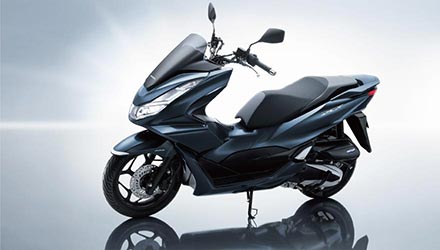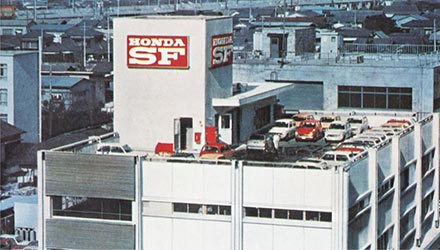Joining Hands with Two Indian Companies
to Develop the Market in a Vast Country
For Honda, which advocates “worldwide customer satisfaction,” proactive expansion of its business outside Japan has been a natural approach. As Honda accelerated its global expansion, efforts to cultivate the motorcycle market in India began in earnest in the 1980s. In India, motorcycles were the dominant mode of transportation in people’s daily lives, and the country’s population of over 700 million was growing at a steady pace. The region had the potential to grow into an enormous market.
However, at that time, India had a planned economic system based on the nationalization of major industries. Importing finished vehicles was not allowed, and the only way for a foreign company to establish a local manufacturing and sales company was to enter a joint venture with local investor on equal footing, with a minority stake of no more than 50% of the voting rights.
Under the planned economy, the inflow of products and technologies from abroad was restricted, and motorcycles produced in India lagged behind in terms of product and production technologies in some areas such as quality and fuel economy improvement. Bajaj Auto, a 100% locally owned company, was the leading manufacturer of motorcycles in India at the time, but its products were rarely making progress, and the motorcycle market as a whole was experiencing little growth.
In light of this situation, Honda decided to participate in the market as an equal management partner (co-executor), an equal investor (shareholder), and a technology and product provider (licensor). Honda took a strategy to collaborate with two local companies, one in the motorcycle business and the other in the scooter business, to gain a foothold in this huge market with the world’s second largest population that had immense potential.
In 1984, Honda formed an alliance with the Hero Group based in Delhi, which had Hero Cycles, the world’s largest bicycle manufacturer at the time, and established Hero Honda Motors Ltd. (HHML). In order to enter the motorcycle market with 100 cc Cub-type models, HHML built a new plant in the Dharuhera area and began production of the CD100 in 1985.

CD100 production at HHML (1988)

Honda jointly establishes HHML with Hero Group, a parent company of Hero Cycles which was the world’s largest bicycle manufacturer at the time.

CD100, First Honda model locally produced in India
Also in 1984, Honda formed a partnership with Kinetic Engineering Ltd., in Pune, located in southern India, and established Kinetic Honda Motor Ltd. (KHML). While Kinetic Engineering was producing and selling mopeds equipped with a compact 2-stroke engine, Honda sought to enter the market with scooter models designed exclusively for India.
At the time, scooters widely available in India were manufactured by Bajaj Auto under a licensing agreement with an Italian motorcycle maker, and they did not exactly accommodate the needs of Indian customers, but neither did Indian motorcycle makers have the technology to meet the needs.
Hideo Tanaka, former president of KHML, said: “What India was looking for at the time was precisely the advanced technology that Honda had amassed in the global motorcycle market.”
Honda also devised a product development method to modify existing models produced in Japan to offer specifications suitable for India.
Masayuki Igarashi, Chief Operating Officer for the Regional Operations (Asia & Oceania) at the time, said: “In general, plastic is often used for exterior parts of scooters, but in India, we decided to use steel plates because many customers own and operate one motorcycle for a long time and prefer steel parts that can be repaired with sheet metal. Also, there was a traditional tendency for customers to demand robustness rather than lightweight.”

NH100 production line at KHML (1988)
Technological Innovations Continue Even While Struggling
to Keep Up with Economic Liberalization
Honda managed to enter the Indian motorcycle market, but it was not all smooth sailing. KHML, which entered the market with scooter models designed exclusively for India, faced price, production and quality challenges. HHML launched 100 cc-class motorcycle models, but they were shunned by customers in India where scooters had been the mainstream and motorcycles were not popular due to the need for shifting gears, the lack of a foot area to carry things and high prices. Both Honda JV companies struggled to gain a certain level of presence in the market.
In 1992, relationships with the two local partners changed as the economic liberalization in India made it possible for foreign companies to establish a company in India with a majority stake (with more than 50% of the voting rights).
In 1994, Honda offered to become the majority shareholder of HHML, but was rejected. Hero gradually increased its management role, while Honda retreated to the position of shareholder and licensor. HHML decided to focus on motorcycles rather than scooters and strived to develop lower-priced motorcycle products, which could appeal to the customers with better fuel economy and durability than scooters.
To pursue this strategy, HHML needed to further improve the fuel economy and durability of its products, and Honda saw this as an opportunity for technological advancement in small-size motorcycles. While making progress in developing technologies to improve fuel economy, Honda made continuous and meticulous improvements to suit the usage environment and desired usability in India. In 1998, Honda R&D India (HRID) was established to conduct R&D for motorcycles and power products.
With KHML, Honda did take a majority stake in 1995; however, as disagreements with its partner over production and quality continued, and the partner company maintained strong influence over the sales network for its own moped products, Honda could not demonstrate its initiative in the KHML operation. As KHML business continued to struggle, KHML was dissolved in 1977.
As Economic Liberalization Accelerates,
Honda Establishes Wholly-owned Subsidiary
The Indian motorcycle market reached 3.25 million units in 1998 and was expected to reach 5 million units by 2005. The strong desire of Honda to increase its presence in this huge market reached a major turning point in 1999, when the liberalization policy was further accelerated making it possible to establish a 100% foreign-owned corporation in India. However, there were conditions, including the need for Honda to gain the approval of Hero, with whom it already had a partnership.
So, Honda agreed to deepen its strategic partnership with Hero and strengthen its product lineup, enabling Honda to establish a new company, Honda Motorcycle and Scooter India Pvt. Ltd. (HMSI). This was the birth of a long-awaited wholly-owned local subsidiary.

HMSI, Honda’s first fully-owned subsidiary in India
HMSI’s business started with scooters, a segment that had been left vacant due to the discontinuation of KHML. The agreement with HHML stipulated that HMSI would produce and sell only scooters for its first five years. The aim was to ensure that HMSI and HHML (whose main business was motorcycles) addressed different segments, and to meet the diversifying needs of the expanding market.
Katsuro Suzuki, former senior managing director and general manager of the Regional Operation (Asia & Oceania), said: “HHML is one of Honda’s most successful businesses in the world. We will continue to support it to bring out its best and strengthen the new product development capabilities of our R&D center in Delhi. I am confident that this will enable both parties to satisfy Indian customers in a spirit of co-existence and co-prosperity.”

Associates and staff celebrate HHML’s one millionth CD100DX (November 1994)
 ACTIVA, the first model produced by HMSI
ACTIVA, the first model produced by HMSI
HHML’s performance was on a steady rise, and in 1997, the company expanded its production capacity by building a second plant in the Gurgaon area, achieving record annual production of 1.03 million units in FY2000. This was the first time an overseas Honda motorcycle production operation surpassed
1 million units per year. At the same time, the company also captured a 26% share of the Indian motorcycle market, finally overtaking Bajaj Auto as the leader.
The new company, HMSI, established a new factory in Manesar near Delhi. With technical assistance from Japan, its associates worked together to start up the plant from scratch and, in spring 2001, only 14 months after construction began, mass production began of its first model, the 4-stroke 100 cc ACTIVA scooter.
Partner Company, HHML, Achieves World’s Highest Production and Sales Volume.
Wholly-owned Honda Subsidiary, HMSI,
Begins Full-fledged Operations
Following HHML's breakthrough and start of full-fledged operation of HMSI, Honda announced in spring 2001 that it would produce and sell 1.75 million motorcycles in FY2004 (fiscal year ending March 31, 2024), or 25% of its worldwide motorcycle sales target of 7 million units, including exports. Both companies continued to grow steadily, and in January 2002, they announced that plans would be brought forward by a year.
HHML’s production and sales exceeded 1.3 million units in FY 2002. On a yearly basis, HHML had achieved the No. 1 position in the world. However, it could not be complacent. In order to solidify its No. 1 position in the rapidly expanding Indian motorcycle market, it was vital for Honda to respond quickly to market change, through planning and formulating products optimal for India and achieving low costs through local procurement.

Passion Plus, HRID’s first locally-produced model
In September 2003, Passion Plus, the first model developed by HRID was launched.
The new company, HMSI, was also off to a good start. Its first model, Activa, reached a cumulative production volume of 100,000 units in the first 15 months of production. It gained more than a 50% share of the mid-size scooter market in India and became a popular model with more than a two-month backlog in orders. In addition, the model was exported from India to Mexico, Guatemala, South Africa, Turkey, Nepal, and other countries, where it was well received. In 2003, HMSI began exporting the LEAD, a 4-stroke 100 cc model for Europe at a low price comparable to the 50 cc model. Sales of scooters produced by HMSI began to expand from India to the rest of the world.

LEAD (European model)
End of Co-existence and Co-prosperity Relationships.
Honda Takes the Next Step After Dissolving the HHML
Joint Venture
HHML, which had grown to become India’s No. 1 motorcycle manufacturer, established its third plant in the Haridwar district of Uttrakhand, northern India, in 2008, with an annual production capacity of 4.6 million units.
Meanwhile, HMSI, which had become the No. 1 scooter manufacturer in India, launched its first motorcycle model, the UNICORN, in 2004. Until then, HMSI had focused on scooter business distinguishing itself from HHML, but five years after its establishment, the company took a new step forward by expanding its lineup to include motorcycles. By 2005, HMSI had achieved a production volume of 1 million units.
The two companies held a series of discussions to find the best framework to meet the increasingly diverse needs of customers in the Indian motorcycle market, expected to continue to grow, and to mutually prosper. As a result in 2010, Honda sold all of its shares in HHML to Hero, and the two companies agreed to enter into a license agreement that allows HHML to continue to manufacture and sell its products, as well as to license new products to be manufactured and sold in the future.
Hiroshi Kobayashi, former chief operating officer of Regional Operations (Asia & Oceania), said: “India is a huge market, and growth here is directly linked to the growth of Honda motorcycle business. Expanding our sales volume in the Indian market is essential to maintain stable growth. It is very significant for the future of Honda motorcycle business to be able to be involved in all aspects of business management in an emerging country while being in closer contact with such important customers and market.”
A quarter of a century after Honda began to cultivate the motorcycle market in India, HHML and HMSI, which had developed through co-existence and co-prosperity, embarked on their own new paths.



